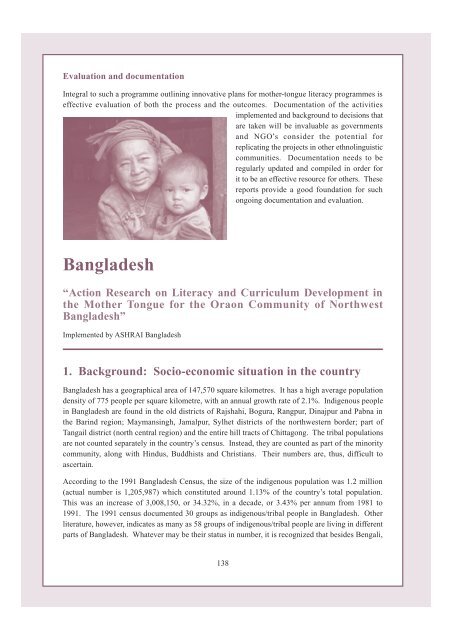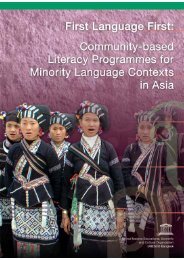Part II.pdf - MTB-MLE Network
Part II.pdf - MTB-MLE Network
Part II.pdf - MTB-MLE Network
Create successful ePaper yourself
Turn your PDF publications into a flip-book with our unique Google optimized e-Paper software.
Evaluation and documentation<br />
Integral to such a programme outlining innovative plans for mother-tongue literacy programmes is<br />
effective evaluation of both the process and the outcomes. Documentation of the activities<br />
implemented and background to decisions that<br />
are taken will be invaluable as governments<br />
and NGO’s consider the potential for<br />
replicating the projects in other ethnolinguistic<br />
communities. Documentation needs to be<br />
regularly updated and compiled in order for<br />
it to be an effective resource for others. These<br />
reports provide a good foundation for such<br />
ongoing documentation and evaluation.<br />
! ! ! ! !<br />
Bangladesh<br />
“Action Research on Literacy and Curriculum Development in<br />
the Mother Tongue for the Oraon Community of Northwest<br />
Bangladesh”<br />
Implemented by ASHRAI Bangladesh<br />
1. Background: Socio-economic situation in the country<br />
Bangladesh has a geographical area of 147,570 square kilometres. It has a high average population<br />
density of 775 people per square kilometre, with an annual growth rate of 2.1%. Indigenous people<br />
in Bangladesh are found in the old districts of Rajshahi, Bogura, Rangpur, Dinajpur and Pabna in<br />
the Barind region; Maymansingh, Jamalpur, Sylhet districts of the northwestern border; part of<br />
Tangail district (north central region) and the entire hill tracts of Chittagong. The tribal populations<br />
are not counted separately in the country’s census. Instead, they are counted as part of the minority<br />
community, along with Hindus, Buddhists and Christians. Their numbers are, thus, difficult to<br />
ascertain.<br />
According to the 1991 Bangladesh Census, the size of the indigenous population was 1.2 million<br />
(actual number is 1,205,987) which constituted around 1.13% of the country’s total population.<br />
This was an increase of 3,008,150, or 34.32%, in a decade, or 3.43% per annum from 1981 to<br />
1991. The 1991 census documented 30 groups as indigenous/tribal people in Bangladesh. Other<br />
literature, however, indicates as many as 58 groups of indigenous/tribal people are living in different<br />
parts of Bangladesh. Whatever may be their status in number, it is recognized that besides Bengali,<br />
138
















